
Chronic Venous Insufficiency (CVI) is a condition that affects millions of people worldwide. It occurs when the veins in the legs do not work effectively, leading to a variety of symptoms and potential complications. Early diagnosis and intervention can significantly improve the quality of life for individuals with CVI.
Understanding the stages of CVI is essential for early diagnosis and effective management. However, it's important to note that CVI is a progressive condition, and the severity of symptoms may vary from person to person.
Let’s delve into the different stages of CVI and discuss the symptoms, causes, and treatment options.
Stage 1: Spider Veins
The first stage of CVI is typically the development of spider veins, also known as telangiectasias. These are tiny, dilated blood vessels that appear just below the surface of the skin. They often resemble a spider's web or tree branches and may be red, blue, or purple. Spider veins are usually asymptomatic but can cause mild discomfort or itching in some cases.
Symptoms:
Causes:
Treatment:
Stage 2: Varicose Veins
As CVI progresses, it often leads to the development of varicose veins. Varicose veins are larger, twisted veins that may bulge and protrude from the skin's surface. They can cause more noticeable discomfort and sometimes pain.
Symptoms:
Causes:
Treatment:
Stage 3: Edema and Skin Changes
In the third stage of CVI, the condition progresses, and patients often experience more severe symptoms. Edema, or swelling, becomes increasingly noticeable, and skin changes are common. These changes may include discoloration, dryness, and inflammation.
Symptoms:
Causes:
Treatment:
Stage 4: Venous Skin Ulcers
The fourth stage of CVI is characterized by the development of venous skin ulcers, open sores that can be painful and slow to heal. These ulcers usually occur near the ankles and are a serious complication of CVI.
Symptoms:
Causes:
Treatment:
Stage 5: Lipodermatosclerosis
Lipodermatosclerosis is a condition that can occur in the advanced stages of CVI. It involves changes in the subcutaneous fat tissue, leading to skin thickening and inflammation. This condition can be extremely painful and disabling.
Symptoms:
Causes:
Treatment:
If you suspect you may have CVI or are experiencing any of the symptoms mentioned; it's crucial to seek medical attention quickly and consult with a vein health professional for a proper diagnosis and treatment. Center for Vein Restoration (CVR), the nation’s leader in varicose and spider vein care, improves lives by providing safe, customized, outpatient treatment options for vein disease.
CVR offers 110+ vein clinic locations across the country. Led by more than 70 experienced, board-certified vein physicians, CVR provides state-of-the-art vascular care in a compassionate and affordable manner. Furthermore, CVR accepts many insurances, including Aetna, Amerigroup, Anthem, Blue Cross/Blue Shield, Cigna, MultiPlan, Medicaid, Medicare, and more.
Call 240-965-3915 to speak to a Patient Services Representative or schedule your consultation online at a CVR near you today.

Remember, a healthy lifestyle, including regular exercise, weight management, and wearing compression stockings, can play a vital role in managing and preventing the progression of CVI. If you have any concerns about your vein health, don't hesitate to contact your CVR healthcare provider. Your legs will thank you for it!
